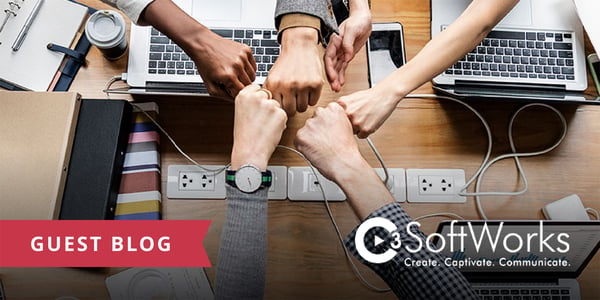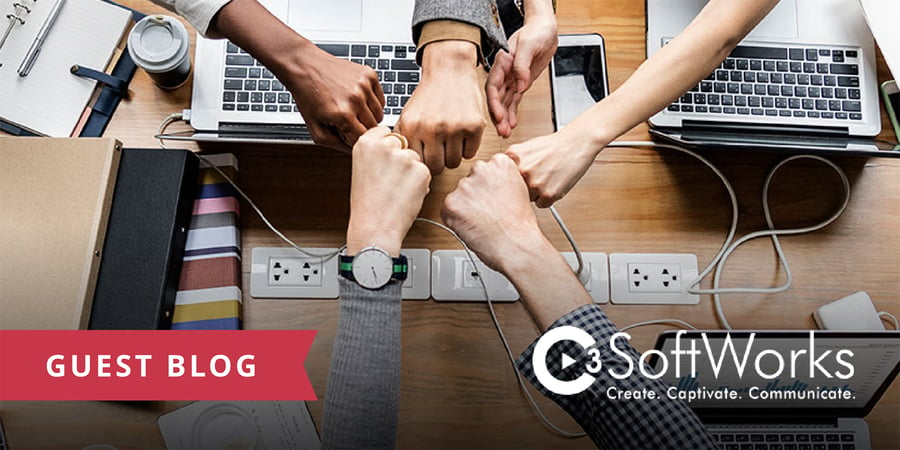


Guest Blog from C3 SoftWorks - Written By: Erin Patrick-Proza
Have you embraced online learning? Does your training program offer your participants a variety of tools and resources to suit their learning style and their schedule? Is it a mix of self-paced and instructor-led sessions? This is the future of learning, and the future is hybrid. In this blog, we will discuss what that means and how gamification tools can be leveraged to release the power of play with serious learning in this environment.
Hybrid learning is a blend of online learning (with extensive digital resources) and traditional classroom sessions, with learning objectives and opportunities throughout the journey. It may look like using learning management systems (LMS) with online modules; video conferencing; online exercises; or pre-recorded videos; with a conventional lecture or team building event, followed up with a digital forum. The idea here is that the online learning should reflect and complement the in-person learning. Most importantly, it is a way to offer the student a choice for the best method of delivery for their unique learning style, and in doing so, places them directly in ownership of their learning process. This ‘on-demand’ kind of learning has been exploding in popularity since the pandemic and seems to be here to stay. According to LiveWebinar (2021), this is due to its many observable benefits:
This is a significant shift from traditional ways of learning, and technology has a large impact on how we are learning today since it is what powers and enables the online component of this approach. Having the right tools at the right time was once a nice-to-have, but now seems to be a need-to-have when considering the diversity of generations by age in the workplace. One-way virtual learning environments will simply not be enough anymore, as the expectations continue to rise around how we learn and how we train. And with more and more people wanting an eLearning option, it’s important to understand why. According to Spark+Co.
“90% of corporations now use eLearning compared to just 4% in 1995.”
+
“Corporate eLearning is estimated to grow more than 250% by the year 2026.”
Of course, in spite of the many studies and statistics on the effectiveness of online learning, there will always be some people and situations that benefit from in-person interaction. So, when we can offer and optimize both of these learning scenarios, we enrich the learning experience and many business metrics as a result, such as the engagement factor as well as knowledge retention. Since flexible learning offers a career pathway for people looking to level up their skills, this can go a long way in retaining your talent and improving your company culture as well.
In the context of serious learning, we’re talking about using games as a fun method of delivering your learning content. Since games can be used in live or self-paced learning, they lend themselves beautifully to an interruptive interaction point in a hybrid learning style. This is important because learning online or virtually is very different from learning in-person and the interaction rate needs to be much higher. In fact, according to the Peak Performance Center, adults can only listen with retention for 20 minutes and need to be involved every 8 minutes. You could argue this would be even less for strictly virtual training. So, for example, before you go into a breakout session, play a game to revisit the concepts you just went over incrementally as opposed to one big review at the end. Or, make sure your in-person lecture follows the ratio of no more than 8 slides of lecture to some activity (we recommend games!) that engages and involves your participants. Play our trivia game below as an example of a fun way to interrupt lectures or reading.
Try your luck at our St. Patrick’s Day Trivia Contest, created with Quiz Show, and earn a chance to win a license to try out the BravoZone for free!
Gamification also taps into a very human driver of motivation: competition. This applies whether they’re competing with others, or with themselves to beat their own highest score. Friendly competition makes learning through games fun with a purpose. When applied consistently and incrementally, you’d be surprised by the amount of buy-in. Games are enjoyed by every age group and genre, so they can be a great connector in that way and bring even the wallflower into the mix. This provides a non-threatening learning environment that can thrive in hybrid learning approaches, where self-paced learning can feel monotonous at times.
One of the biggest benefits of hybrid learning is its flexibility. This also allows the space for everyone’s learning path to be respected and represented. During the pandemic, working and learning remotely quickly became the norm and we’ve made many adjustments to accommodate this. As a result, we’ve also gained new perspectives on what productivity looks like and how companies can operate. However, the biggest challenge in this ‘new normal’, according to many of our clients, is keeping people engaged, connected, and on the same page in a virtual world.
So here’s why games work: Games are mobile and can be used in a variety of ways, from a microlearning approach with self-paced learning to a knowledge check in a live session. They can pack a powerful punch (of fun) in a small amount of time to increase engagement and knowledge retention. Try our self-paced quiz below as an example of a way to include interactive learning, even when it’s asynchronous.
Review time! Try this self-paced quiz to test your knowledge of hybrid learning!
Integrating games into your hybrid learning program is great for a number of leadership skills as well: soft skill development, professional development, or your general compliance or review content, based on its ability to be participant-centered. It can also be used situationally and scaled for scenario training, such as sales or product knowledge. It’s designed to be short and sweet for multi-media consumption, so it can be easily accessible with devices such as phones and tablets, which keeps people mobile and flexible for on-demand learning. This allows the focus to be on performance gains with valuable feedback and creating quality content that people love, all while using games to deliver your information to an informal and safe learning environment. And, by turning your content into fun, engaging, and interactive sessions you can pull all learning styles into the fold, no matter the subject matter. All of this can help prompt positive changes in behavior and engagement. But don't take our word for it:
"We used the Catapult game to teach 7 key elements behind why participant-centered training works. We literally laughed every 1-2 minutes. There was so much energy! We love your products, we are fans and excited for the future!"
-Becky Pike Pluth (The Bob Pike Group)
At C3 SoftWorks, we’re passionate about helping people find unique solutions to their training and education goals and have over 35 years of experience in those fields. We strive to make gamification easy and our single but powerful platform can deliver many ways to make your training more engaging. If you’d like some ideas on navigating a hybrid learning environment using games, we’re here to help.
Don't miss out on updates and chances
to sharpen your skills with participant-centered learning.




3740 N Chestnut St #113 - Chaska, MN 55318-3053